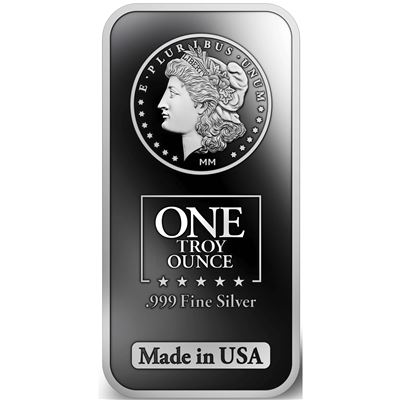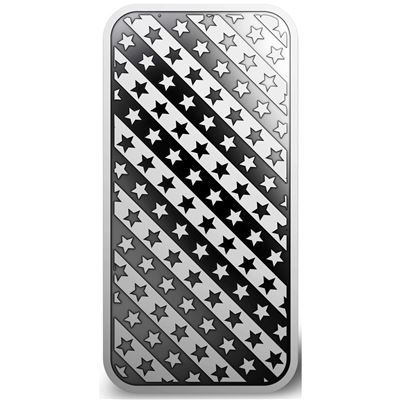1 oz Mason Mint Silver Bar - Morgan Design




| Qty | Check / Bank Wire |
Crypto
We are now accepting Bitcoin (BTC), Bitcoin Cash (BCH), Ethereum (ETH), Litecoin (LTC), Dai (DAI), and USD Coin (USDC) as a payment method on our website!
|
Credit Card |
|---|---|---|---|
| 1+ | $60.85 | $62.07 | $62.98 |
Product Highlight:
- Made in the USA
- One Troy Ounce .999 Fine Silver
- Famous Morgan Head Design On Top Of Bar
- "Generic" Silver Has Lower Premiums Than Coins


Buy 1 oz Mason Mint Silver Bar - Morgan Design
Buy 1 oz Mason Mint Silver Bar - Morgan Design
.999 Fine Silver | American-Made Quality
What is the 1 oz Mason Mint Silver Bar - Morgan Design?
The 1 oz Mason Mint Silver Bar - Morgan Design is a premium investment-grade silver bullion bar containing one troy ounce of .999 fine silver. Manufactured by Mason Mint in Florida, it features the iconic Morgan Liberty design from the historic 1878-1921 U.S. silver dollar.
- Contains 1 troy ounce (31.1035 grams) of .999 pure silver
- Features George T. Morgan's classic Liberty portrait design
- ISO 9001:2015 certified manufacturing quality
- IRA-eligible for precious metals retirement accounts
- Competitive premiums over spot silver price
Premium silver bullion featuring America's most beloved coin design
Quick Facts at a Glance
Own a piece of American numismatic heritage with the 1 oz Mason Mint Silver Bar featuring the iconic Morgan design. This premium silver bar combines Mason Mint's ISO 9001:2015 certified quality with George T. Morgan's legendary 1878 Liberty design, offering investors and collectors exceptional value at competitive premiums. Each bar contains exactly one troy ounce of .999 fine silver, making it perfect for both new investors building their first silver stack and experienced collectors seeking American-made quality.
Product Specifications
Physical Characteristics
Composition & Mint
Silver Bar Comparison Guide
| Feature | Mason Mint Morgan | Generic Silver Bar | Government Mint Bar |
|---|---|---|---|
| Premium Over Spot | Low-Moderate | Lowest | Highest |
| Design Appeal | Historic Morgan Design | Basic/Minimal | Varies by Mint |
| Quality Certification | ISO 9001:2015 | Varies | Government Backed |
| IRA Eligible | Yes | If .999 Fine | Yes |
| Made in USA | Yes | Varies | Depends on Mint |
| Collectibility | Moderate-High | Low | High |
Premium American Craftsmanship Meets Historic Design
The Mason Mint Silver Bar represents the perfect marriage of modern minting excellence and timeless American artistry. Based in Dade City, Florida, Mason Mint has earned its reputation as a trusted producer of investment-grade silver bullion since 2012. Their ISO 9001:2015 certification ensures every bar meets rigorous international quality standards, while their "Excellence In Minting" philosophy delivers products that rival premium brands at significantly lower premiums.
The Morgan design adorning this bar carries 140+ years of American heritage. Originally created by English-born engraver George T. Morgan for the U.S. silver dollar (1878-1921), this design has become synonymous with the American frontier era. The detailed Liberty portrait, based on Philadelphia schoolteacher Anna Willess Williams, features the iconic Phrygian cap topped with agricultural symbols representing American abundance.
Design Excellence and Historical Significance
The Morgan Liberty Design
The obverse features the iconic Morgan Liberty design with clear weight and purity markings: "ONE TROY OUNCE" and ".999 FINE SILVER." This beloved design showcases Lady Liberty in profile wearing a Phrygian cap adorned with cotton blossoms and wheat stalks, symbolizing American agricultural abundance. The intricate details and flowing hair capture the artistry that made the original Morgan dollar one of America's most cherished coins.
Mason Mint Excellence
The reverse displays Mason Mint's distinctive crowned shield logo with the letter "M" and their "Excellence In Minting" motto. A repeating diagonal pattern enhances both aesthetics and security, while the clean design provides clear identification of this American-made product. Unlike cast or poured bars, these precision-struck bars offer consistent thickness and sharp detail reproduction.
Investment Benefits for Your Portfolio
Smart Investment Choice
The Morgan design offers unique advantages for today's precious metals investors. While original Morgan silver dollars command significant numismatic premiums, these modern silver bars provide access to the same iconic design at prices much closer to spot silver. This efficiency allows investors to acquire more physical silver per dollar invested while still enjoying the aesthetic and historical appeal of the Morgan design.
Market Opportunity
Current market conditions make silver particularly attractive. With industrial demand for silver forecast to exceed 700 million ounces in 2025 driven by solar panel production, electric vehicles, and emerging technologies, silver faces a structural supply deficit. Meanwhile, persistent inflation concerns and currency devaluation risks continue to drive investment demand for physical precious metals.
Portfolio Protection
Physical silver serves multiple roles in a well-diversified investment portfolio. As a proven hedge against inflation, silver has maintained purchasing power across decades of currency devaluation. The 1 oz size offers optimal flexibility for investors - affordable enough for regular accumulation through dollar-cost averaging, yet substantial enough to build meaningful positions over time.
Comprehensive Quality Assurance and Authenticity
Mason Mint ISO Certification
Mason Mint's ISO 9001:2015 certification isn't just a credential – it's a comprehensive quality management system that governs every aspect of production. This international standard requires documented procedures, regular audits, and continuous improvement processes. For buyers, this means consistent quality, accurate weights, and reliable purity in every bar.
Authentication Features
Authentication features built into the design provide additional security:
- Precise striking process ensures sharp design reproduction
- Detailed Morgan Liberty portrait requires sophisticated minting equipment
- Mason Mint hallmarks offer unique identifiers
- Protective packaging preserves condition
Current Market Analysis
Strong demand in 2025's economic landscape
As investors navigate today's evolving global economy, physical silver continues to serve as a reliable store of value. The 1 oz Mason Mint Silver Bar - Morgan Design offers proven stability and growth potential while connecting investors to American numismatic heritage.
Recent market factors supporting silver investment include:
Why Buy Your Mason Mint Silver Bar from GainesvilleCoins.com
Your trusted precious metals partner since 2006
At GainesvilleCoins.com, we've built our reputation on providing authentic precious metals at competitive prices with exceptional customer service. When you purchase your 1 oz Mason Mint Silver Bar - Morgan Design from us, you receive:
Flexible purchase options for every investor
Whether you're buying your first Mason Mint Silver Bar or adding to an established stack, we offer convenient options:
- • Individual bars in protective packaging
- • Tubes of 20 bars for volume purchases
- • Dollar-cost averaging for regular accumulation
- • Bulk pricing for larger orders
Additional Common Questions
While American Silver Eagles carry government backing and higher premiums, Mason Mint Morgan bars offer the same .999 fine silver content at significantly lower premiums. Both are IRA-eligible, but the Mason Mint bar provides better value for investors focused on accumulating silver ounces rather than government-minted products.
Track your investment by monitoring the spot price of silver and adding the premium you paid. Most investors use portfolio tracking apps or spreadsheets to record purchase dates, quantities, and prices. The 1 oz size makes calculations simple - multiply your bar count by the current spot price plus typical selling premiums.
Yes, Mason Mint bars are widely recognized and accepted by precious metals dealers nationwide. The .999 fine silver content and recognizable Morgan design ensure good liquidity. Most dealers buy back at or slightly below spot price, making these bars easy to sell when needed.
Frequently Asked Questions
Everything you need to know about Mason Mint Silver Bar investment
What makes Mason Mint bars special?
Mason Mint bars feature ISO 9001:2015 certified quality, iconic American designs like the Morgan Liberty, and competitive premiums. Their "Excellence In Minting" philosophy delivers premium quality at accessible prices, making them ideal for both investors and collectors.
Are Mason Mint Silver Bars IRA-eligible?
Yes, the .999 fine silver purity meets IRS requirements for precious metals IRAs. This allows investors to hold these bars in tax-advantaged retirement accounts while enjoying the same inflation protection and wealth preservation benefits.
How should I store my silver bars?
Store your bars in a secure location such as a bank safe deposit box or home safe. Keep bars in their protective packaging to maintain condition and prevent tarnishing. Avoid handling directly to preserve the surface quality.
What is the Morgan design's significance?
The Morgan design represents one of America's most beloved coin designs, originally created for silver dollars from 1878-1921. It features Lady Liberty and symbolizes the American frontier era, making it highly recognizable and collectible among precious metals enthusiasts.
Storage Recommendations
Protect your Mason Mint Silver Bar investment with proper storage:
Note: Silver prices fluctuate throughout the trading day. The price shown reflects current market conditions and is subject to change. Secure your investment by completing your order today.
Secure Your Piece of American Heritage Today
The 1 oz Mason Mint Silver Bar - Morgan Design represents more than an investment—it's your connection to American numismatic heritage combined with modern minting excellence. With competitive premiums and proven quality, now is the time to add this exceptional silver bar to your portfolio.
Order your 1 oz Mason Mint Silver Bar - Morgan Design today and join investors who appreciate the combination of iconic American design, ISO-certified quality, and accessible precious metals investing. With GainesvilleCoins.com's competitive pricing and expert service, building your silver stack has never been easier.
GainesvilleCoins.com Assurance
Every Mason Mint Silver Bar from GainesvilleCoins.com is guaranteed authentic and comes with our commitment to excellence. We've been serving precious metals investors since 2006, building trust through competitive pricing, expert authentication, and exceptional customer service.
Contact our precious metals specialists at 1-813-482-9300 or order online 24/7 for immediate processing.
Disclaimer: The information on this page is for educational purposes only and should not be considered financial advice. Precious metals investments involve risk, and past performance does not guarantee future results. Always conduct thorough research and consult with qualified financial professionals before making investment decisions. Gainesville Coins is not responsible for typographical or pricing errors.


